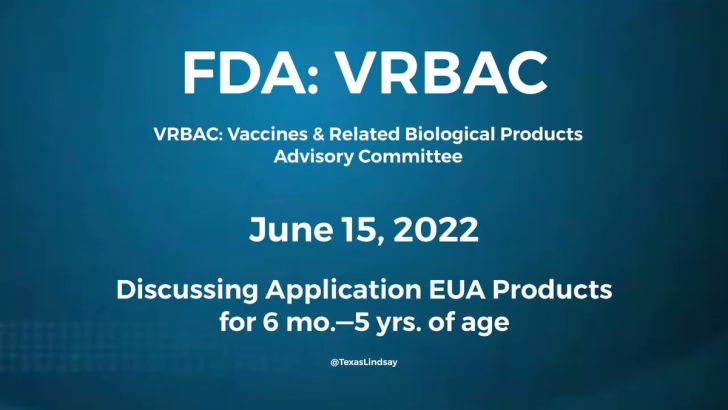DISTURBING: Health Canada Did Not Conduct a Risk-Benefit Analysis Before Authorizing COVID-19 Vaccines for Children
Exclusive government documents show that Health Canada’s expedited authorization of the novel mRNA COVID-19 vaccines for children came with all risks, and real-world data show no benefits.
One-time or recurring donations can be made through Ko-Fi:
By Tamara Ugolini June 07, 2024
Canada’s health regulator rubber-stamped the rushed-to-market novel COVID-19 mRNA vaccines, proving that the agency does not conduct independent safety testing nor uphold evidence-based decision-making.
In a vindication of what many have been saying for years since the rollout of the novel vaccine products, initially said to be 100% effective at preventing COVID-19 infection, it’s clear through exclusive government documents and early reporting that the authorization was based on feelings, not facts.
Since May 2021, when the government began discussing authorizing COVID-19 mRNA vaccines for children, Rebel News has sought the data justifying this decision.
It all started in an email sent from Senior Regulatory Affairs Officer for Health Canada, Samar Eassa, on April 16, 2021, requesting authorization of Pfizer’s novel COVID-19 mRNA injection for children aged 12-15.
This review took less than a month — commencing on April 19, 2021, and completed on May 11.
Health Canada reviewers made notes of Pfizer’s clinical trial data throughout the documents.
It’s noted throughout that Pfizer’s novel mRNA shot was “well tolerated” based on the manufacturer's Phase 3 study in adolescents aged 12-15. The trial was structured so that participants self-reported for a measly follow-up period of at least two months after the second dose before the trial was unblinded.
The novel injections were not determined to be safe or effective but, well tolerated.
Even that was a strong assertion, based on a minuscule number of study participants. While at the time it’s noted that study C4591001 remains ongoing, it’s explained that 98.3 percent of adolescents had at least one month of follow-up after dose one, whereas a measly 57.9 percent of participants were followed for at least two months after dose two.
That’s barely more than half of the participants followed for a mediocre two months after their second dose.
The clinical trial had a very small number of participants. According to Pfizer's documents, only 2,000 participants were enrolled for the 12-15 age group, and just 1,000 of them received the vaccine. If only 58% had two months of follow-up, Health Canada based their safety and efficacy claims on just 580 children who were monitored for two months after their second dose.
In March 2021, Chief Public Health Officer Theresa Tam knew the sample size was very small, but she still approved and promoted these injections for children, aware that the full risks wouldn't be known until the experiment was unleashed onto millions of trusting Canadians and their children.
Nonetheless, Health Canada’s Safety and Efficacy assessment report breaks some of the results of that minuscule sample size down.
It starts by confirming that this novel injection is “indicated for active immunization to prevent [emphasis my own] coronavirus disease 2019 (COVID-19).”
This was despite real-world data showing that the injections weren’t preventing COVID-19 infection. Indeed, by April 2021 the new phenomena called “breakthrough infections” were happening so frequently, that even the pharma-manipulated mainstream media couldn’t ignore it.
Aside from the fact that it was well documented the shots did not prevent infection, the documents used by Health Canada to authorize this injection make it very clear that reactions, across the board, increased in frequency after the second dose.
“Medication use increased in both age groups after Dose 2 as compared with after Dose 1,” it reads.
Within the mediocre seven-day follow-ups after dose one, there was fatigue marked as severe, which is described as “prevents daily activity,” in 15 participants, a number that nearly doubled to 26 after dose two.
Severe headaches that prevented daily activity occurred in 11 children after dose one and doubled to 22 children after dose two.
Chills so severe that they prevented daily activity occurred in five child test subjects after dose one, a number that quadrupled to 20 after dose two.
Vomiting, again so severe that it required intravenous hydration, occurred in one child test subject after dose one. Muscle pain so severe that it prevented daily activity occurred in two child test subjects after dose one, which tripled to six after dose two.
Overall, systemic reactions occurred in 77.8% of all child test subjects after dose one, and 82.4% of them after dose two.
The use of pain medication occurred in 36.6 percent of child test subjects after dose one, and 50.8% after dose two.
The study details that serious adverse events occurred at double the rate of those compared to the placebo, yet none of them were marked by the investigator as related to the experimental product. That is, apart from one adverse event leading to withdrawal from the experiment in each vaccinated group (one for the 12-15 demographic and another in the 16-25 demographic), and one life-threatening incident in 12-15-year-olds.
One withdrawal had a fever of 40.4 degrees Celsius, that occurred two days after dose one and lasted for three days.
The life-threatening adverse events are also described by Pfizer.
One participant had an anaphylactoid reaction — they had originally received the placebo, then received the first dose of Pfizer’s experimental shot when the trial was unblinded. The allergic reaction was so severe that they withdrew from the study.
Another child had also crossed over to receive their first dose after receiving the placebos and became persistently depressed, leading to withdrawal from the study, but this was considered unrelated.
In assessing the adult portion of the experiment, that is, those aged 16 – 55, there were a total of “7 deaths reported among phase 2/3 adult participants” through the unblinding date — three from the original vaccine arm and four from the crossed-over placebo arm, but none of them were assessed by the investigator as related to the study.
Severe adverse events in the adult group were noted as appendicitis, acute myocardial infarction (heart attack), cellulitis, urinary tract infections, intervertebral disc protrusion, subarachnoid hemorrhage (brain bleed) and deep vein thrombosis (clots). None of these were considered by the investigator to be related to the study.
Seven child test subjects developed lymphadenopathy (swollen lymph nodes), which usually indicates an infection or illness.
In the safety evaluation, it’s noted that “the safety data remain limited in the adolescents 12-15 years of age” and that “The safety follow-up period is relatively short. Post-marketing surveillance is required in the adolescent population.”
Health Canada knew all of this before they rubber-stamped this injection and then promoted it to Canadian children through perverse marketing campaigns, which Canadian taxpayers paid approximately 10 million dollars for.
Health Canada concludes that “Based on the totality of the information, the benefit-risk profile of Pfizer-BioNTech COVID-19 vaccine is considered favourable for active immunization in individuals 12 to 15 years of age.”
The agency expected media scrutiny over the weak clinical trial data supporting the safety and efficacy of these novel injections in adolescents, as Canada was the first to authorize them. However, as shown in a previous report, the media echoed Big Pharma's marketing and pushed to eliminate parental consent for children seeking experimental injections.
Pfizer was told to provide safety data for all children 12-15 years of age in study C4591001, six months after dose two, when the data became available.
Secondly, they were instructed to provide a study C4591001 report including safety, efficacy and immunogenicity data up to two years after dose two in children 12-15 years of age, when the data become available. Just casually, whenever.
According to the clinical trial website, study C4591001 concluded on February 10, 2023
Results were submitted a day prior and underwent a quality control review as of March 6, 2024.
Disturbingly, this Quality Control Review has not been concluded, because of errors, deficiencies or inconsistencies.
At various points throughout the inconclusive review, the National Library of Medicine Quality Control Review Comment notes things like “information within the measure appears inconsistent” and “the unit of measure appears invalid,” “measure types appear inaccurate” or, “the explanation provided is not sufficient to understand why one or more values are not available.”
These discrepancies appear throughout the results submission a total of 38 times.
Regardless, Health Canada trusted the known fraudster Pfizer when they determined “the benefit-risk profile of the Pfizer-BioNTech COVID-19 vaccine is considered favourable for active immunization in individuals 12 -15 years of age.”
“The Pfizer-BioNTech COVID-19 Vaccine is therefore recommended for authorization for active immunization to prevent coronavirus disease 2019 (COVID-19) caused by severe acute respiratory syndrome coronavirus 2 (SARS-Co V-2) in adolescents I 2 to 15 years of age. Based on cases reported from at least 7 days after the administration of Dose 2, the efficacy of Pfizer-BioNTech COVID-19 vaccine was 100% effective,” the agency concluded.
100 percent effective based on a seven-day follow-up of 500 participants!
One Health Canada reviewer at least acknowledges that Pfizer’s “clinical study was not designed to assess vaccine efficacy on prevention of transmission,” but they “expected [emphasis added] that an efficacious vaccine would convert severe cases to mild cases and mild cases to asymptomatic.”
It would be hard to prove efficacy when according to Pfizer’s study outcomes, asymptomatic infection rates between both the vaccinated and placebo arms were… the same.
As discussed with Deanna McLeod of the pharmaceutical reviewing company Kaleidoscope Strategic, Pfizer’s adult trial data showed that the vaccine profiteer misrepresented data to hide the fact that the novel injectables came with an increased risk of illness and death compared to the placebo.
Issues included early unblinding of participants, and the use of misleading demographics — primarily using healthy young people in the trial, when the shots were first rolled out on the “most vulnerable” sick and elderly at a population level. The trial lacked biomarker trackers – something that could have picked up on clotting factors, inflammation, cardiac damage, blood pressure changes, immune system disruptions etc.
The study's authors also had massive conflicts of interest, making 84% of them compromised.
In an attempt to confirm why these injections remain on the market, still recommended for everyone aged six months and up, Rebel News inquired with Health Canada’s media contact to confirm what benefits these injections offer Canadians, how the agency continues to justify their authorization, the long-term risks and details surrounding any risk-management plan.
No one responded to the request, but based on a response from the Biologic and Radiopharmaceutical Drugs Directorate (BRDD) division of Health Canada on June 1, 2021, these shots were authorized for children because they would protect communities.
“The Pfizer-BioNTech vaccine will play an important role in protecting younger Canadians, their families, and their communities from COVID-19 illness, hospitalization and death,” the email from BRDD reads.
Yet none of that was part of the trial outcomes, and so none of it was studied or able to be ascertained.
Nonetheless, BRDD repeated this unfounded talking point.
“The availability of safe and effective vaccines will reduce the spread and severity of COVID-19 disease and reduce its social and economic consequences,” the email goes on.
June 9 correspondence from the same further described “vaccine acceptability of parents and guardians” as reasons for authorizing the novel injections.
The BRDD then dedicated a paragraph trying to prove that children were asymptomatic superspreaders of COVID infection, once again reiterating “The availability of safe and effective vaccines will reduce the spread and severity of COVID-19 disease and reduce its social and economic consequences.”
They included a pre-print pretend modelling paper co-authored by conflict-of-interest-riddled David Fisman as evidence to allude to schools being safer once these products were authorized. In that email, they also conclusively state that “Health Canada’s review of COVID-19 vaccines and therapeutic products is based on a qualitative risk-benefit calculation at the population and public health level.”
This validates the June 16, 2021 report, which concluded that feelings, not facts, were driving Health Canada's decision and subsequent push to vaccinate children against COVID-19.
Related articles:













Neither did USA. Nobody cared about this. They rushed to get back to “normal” and I watched the madness mainly coming from NY and CA with their tv propaganda and lockdowns promising to get back to normal and “ We’re all in this together” . Well fuck that
They did not conduct such studies in US, either. Moreover, at birth defects professional conferences, CDC insisted that COVID jabs did not have any side effects among pregnant women and lamented about low “vaccine” uptake. Yes, they still gaslight OBGYNs to jab every pregnant woman they see against COVID. This is even worse than jabbing children.